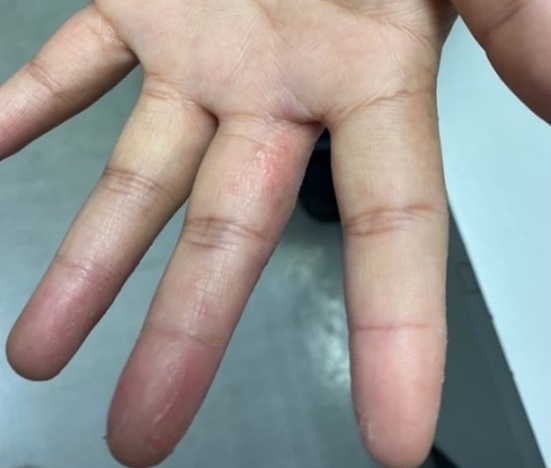Occupational Contact Dermatitis Caused by Methylisothiazolinone: A Hidden Culprit in the Workplace
Keywords:
Occupational contact dermatitis, methylisothiazolinone, walk-through survey, automotive and motorcycle engine factory, mathias criteriaAbstract
Occupational contact dermatitis is a diagnosis of a disease caused by exposure to allergens and/or irritants in working processes. Skin lesions improve during days off but worsen when returning to work. We report a case of a female patient with erythematous papules and deep-seated vesicles on the erythematous base with swelling on both hands. Based on data obtained from her occupational history and a walk-through survey of the automotive and motorcycle engine factory where she worked, she was exposed to various chemical agents while wearing nitrile gloves, toluene and hand sanitizers, which can also trigger contact dermatitis. Initially, she had skin lesions on both hands after a week of working on a production line. Her lesions improved during days off, however the skin problem persisted after she changed her work position. Patch test results correlated with exposure to hand sanitizers containing methylisothiazolinone. The final diagnosis was occupational allergic contact dermatitis. In conclusion to diagnose occupational contact dermatitis, it appears necessary to conduct a walk-through survey and refer patients for patch testing.
References
Occupational safety and health guideline for carbon black potential human carcinogen [Internet]. United States of America: Centers for Disease Control and Prevention; 1988 [cited 2021 July 10]. Available from: https://www.cdc.gov/niosh/docs/81-123/default.html.
Johansen JD, Aalto-Korte K, Agner T, Andersen KE, Bircher A, Bruze M et al. European Society of Contact Dermatitis guideline for diagnostic patch testing - recommendations on best practice. Contact Dermatitis. 2015;73(4):195-221.
Shakik S, Arrandale V, Holness DL, MacLeod JS, MaLeod CB, Peter A, Demers PA. Dermatitis among workers in Ontario: results from the Occupational Disease Surveillance System. Occup Environ Med 2019;76:625-31.
Salako KB, Chowdhury MMU. Occupational skin disoder. In: Ladou J, Harrison RJ, editors. Current Occupational and Environmental Medicine. 5th ed. San Francisco: McGraw Hill Medical; 2014.p.324-38.
Mathias CGT. Contact dermatitis and workers compensation: criteria for establishing occupational causation and agravation. J Am Acad Dermatol 1989;20:842-8.
Workmen's Compensation Fund Social Security Office. Occupational skin diseases. Bangkok: Workmen's Compensation Fund Social Security Office;2007.
Aerts O, Goossens A, Lambert J, Lepoittevin JP. Contact allergy caused by isothiazolinone derivatives: an overview of non-cosmetic and unusual cosmetic sources. Eur J Dermatol 2017;27:115-22.
Silva V, Silva C, Soares P, Garrido M E, Borges F, Garrido J, et al. Isothiazolinone Biocides: Chemistry, Biological, and Toxicity Profiles. Molecule 2020;25:1-22.
Herman A, Aerts O, Montjoye DL, Tromme I, Goossens A, Baeck M. Isothiazolinone derivatives and allergic contact dermatitis: a review and update. J Eur Acad Dermatol Venereol 2019;33:267-76.
Schwensen JF, Uter W, Bruze M, et al. The epidemic of methylisothiazolinone: a European prospective study. Contact Dermatitis 2017;76:272-9.
Thanomkitti K, Kasemsarm P. Occupational Contact Dermatitis in Tertiary University Hospital: A 5-Year Retrospective Study. J Med Assoc Thai 2014;97:1182-8.

Downloads
Published
How to Cite
Issue
Section
License
เนื้อหาและข้อมูลในบทความที่ลงตีพิมพ์ในวารสารโรคผิวหนัง ถือเป็นข้อคิดเห็นและความรับผิดชอบของผู้เขียนบทความโดยตรงซึ่งกองบรรณาธิการวารสาร ไม่จำเป็นต้องเห็นด้วย หรือร่วมรับผิดชอบใดๆ
บทความ ข้อมูล เนื้อหา รูปภาพ ฯลฯ ที่ได้รับการตีพิมพ์ในวารสารโรคผิวหนัง ถือเป็นลิขสิทธิ์ของวารสารฯ หากบุคคลหรือหน่วยงานใดต้องการนำทั้งหมดหรือส่วนหนึ่งส่วนใดไปเผยแพร่ต่อหรือเพื่อกระทำการใดๆ จะต้องได้รับอนุญาตเป็นลายลักอักษรจากบรรณาธิการวารสารโรคผิวหนังก่อนเท่านั้น


